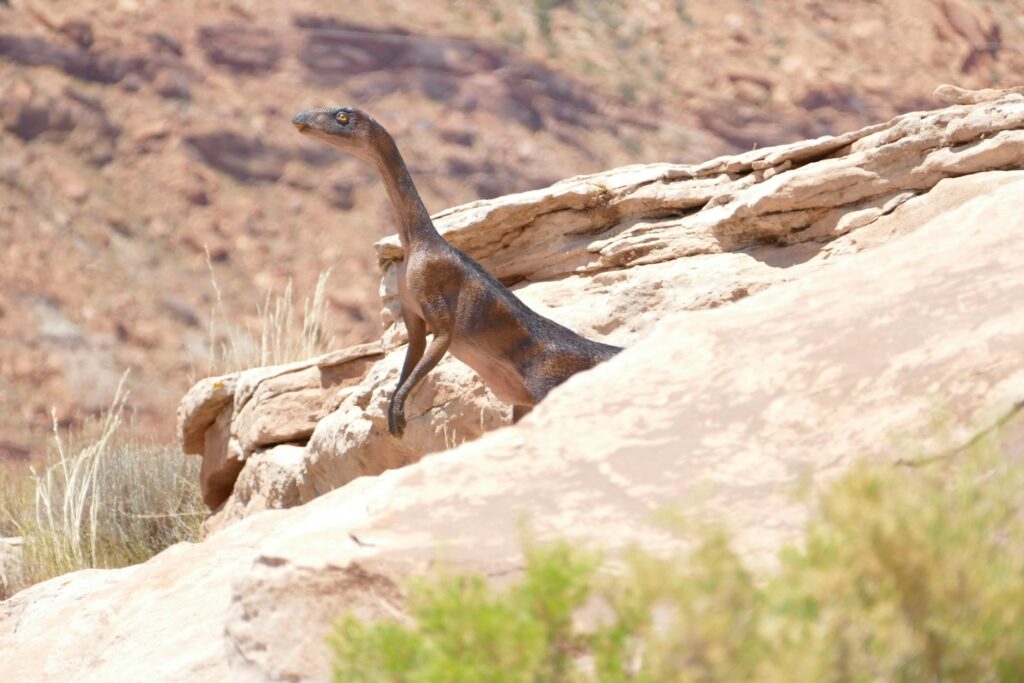Dinosaurs, those magnificent rulers of prehistoric Earth, have captivated our imagination since their fossils were first identified. While we can study their bones, tracks, and other physical remains, understanding their behavior presents a fascinating challenge for paleontologists. Territorial behavior—how dinosaurs defended resources, attracted mates, and interacted with competitors—remains one of the most intriguing aspects of dinosaur ecology.
Through careful analysis of fossil evidence, comparison with modern animals, and innovative research techniques, scientists have developed compelling theories about how these ancient creatures may have established and defended their territories across the Mesozoic landscape.
The Challenge of Studying Extinct Behaviors

Understanding territorial behavior in animals that disappeared 66 million years ago presents unique scientific challenges. Unlike studies of living species, where scientists can directly observe territorial displays, confrontations, and boundary marking, dinosaur behavior must be inferred through indirect evidence. Fossil records provide snapshots of anatomy and occasionally preserved interactions, but cannot capture the full complexity of behavioral patterns.
Paleontologists must therefore employ multiple lines of evidence—including bone morphology, trackways, nesting sites, and comparative studies with modern relatives—to piece together plausible behavioral reconstructions. This detective work requires careful interpretation and a willingness to revise theories as new evidence emerges. Despite these limitations, researchers have made remarkable progress in developing credible hypotheses about dinosaur territoriality.
Evidence from Bone Structures

Certain dinosaur anatomical features strongly suggest territorial behavior comparable to that seen in modern animals. Elaborate crests, frills, and horns found in ceratopsians like Triceratops likely served multiple functions beyond physical protection, potentially including territorial displays. The bone structure of many dinosaur skulls shows signs of stress-bearing adaptations that would support head-butting or pushing contests similar to those seen in present-day deer or bison.
Pachycephalosaurs, with their distinctive dome-shaped skulls reinforced with up to 10 inches of solid bone, present perhaps the most compelling case for ritualized combat. Microscopic examination of these domes reveals evidence of healed injuries consistent with head-butting behaviors. These physical adaptations strongly imply that at least some dinosaur species engaged in direct competition for territories or mates, using their specialized anatomy as weapons or displays in territorial confrontations.
Trackway Evidence of Territorial Patterns

Fossilized dinosaur footprints provide valuable insights into movement patterns that may reflect territorial behavior. Concentrations of tracks in specific areas suggest repeated use of the same pathways, potentially indicating established territories with regular patrolling. In some locations, paleontologists have discovered trackways that appear to circle specific areas, suggesting boundary-marking behaviors similar to those observed in modern territorial animals.
Particularly revealing are trackways showing evidence of social interactions, such as multiple individuals moving together or confrontational positioning. In the famous Paluxy River trackways in Texas, researchers have identified patterns suggesting one theropod dinosaur may have been following another, potentially in a territorial dispute or predatory pursuit. While interpretation requires caution, these preserved movement patterns offer rare glimpses into the spatial behaviors of dinosaurs and how they might have established and maintained territorial boundaries.
Nesting Sites as Evidence of Defense Zones

Dinosaur nesting grounds provide compelling evidence for territorial behavior, particularly among certain species that nested in colonies. Excavations of these sites reveal that many species, especially hadrosaurs and sauropods, returned to the same locations generation after generation to lay their eggs. These nesting grounds often feature carefully spaced nests that suggest individuals maintained specific distances from neighboring dinosaurs—a pattern consistent with territorial spacing.
The famous “Egg Mountain” site in Montana shows that Maiasaura maintained nests approximately seven to nine meters apart, suggesting coordinated spacing that balanced protection with resource competition.
In Argentina, massive sauropod nesting grounds contain thousands of eggs arranged in distinct clutches, indicating complex social structures that likely involved territorial defense of nesting spots. The organization of these sites strongly suggests that parent dinosaurs actively defended their nesting territories against conspecifics and predators, exhibiting territorial behaviors similar to those observed in modern nesting birds.
Sexual Dimorphism and Territorial Display

Sexual dimorphism—physical differences between males and females of the same species—often provides clues about territorial and mating behaviors in extinct animals. In numerous dinosaur species, paleontologists have identified potential sexual dimorphism that suggests territorial competition, particularly among males. Ceratopsians like Protoceratops show evidence of differential frill development, with some individuals (presumed males) possessing larger, more ornate frills that likely served as visual displays in territorial contests.
Similarly, the elaborate crests of lambeosaurine hadrosaurs, such as Parasaurolophus, may have functioned as both visual signals and resonating chambers for producing distinctive calls that could establish territorial boundaries through sound. The famous sail-backed Spinosaurus may have used its dramatic neural spines not only for thermoregulation but also as an impressive visual display to intimidate rivals encroaching on its territory.
These sexually dimorphic features strongly parallel those seen in modern territorial species like peacocks, frigatebirds, and many reptiles, suggesting similar behavioral functions among dinosaurs.
Predator Territory Size and Hunting Ranges

Predatory dinosaurs likely maintained hunting territories scaled to their body size and metabolic needs, similar to modern carnivores. By analyzing fossilized teeth and bone accumulations, researchers can identify areas where certain predators were more active, potentially indicating territorial boundaries. Large theropods like Tyrannosaurus rex would have required extensive territories to support their considerable energy requirements, perhaps spanning dozens or even hundreds of square kilometers.
Evidence from the Hell Creek Formation suggests adult T. rex may have maintained distinct territories with minimal overlap, as their fossil distribution shows certain spatial patterns consistent with territorial separation. Smaller predators like Velociraptor likely established more compact territories, potentially hunting in family groups within defended areas.
The distribution of different predator species across ancient landscapes also reveals potential ecological separation, where different predatory dinosaurs established territories in specific habitat types to minimize competition, much as we see with modern predators like lions, leopards, and cheetahs occupying different niches within the same general ecosystem.
Herding Behavior and Group Territories

Many herbivorous dinosaurs appear to have lived in herds, potentially defending collective territories rather than individual ranges. Mass bone beds containing dozens or even hundreds of individuals of the same species, such as those found for Edmontosaurus, Maiasaura, and Centrosaurus, provide strong evidence for herding behavior. These social groups would have required substantial foraging areas to sustain their nutritional needs, likely establishing and defending large group territories against other herds.
Trackway evidence further supports this hypothesis, with multiple parallel footprint pathways indicating coordinated group movement. The composition of these herds often included individuals of various ages, suggesting family units that remained together for protection and resource access.
In modern ecosystems, herd animals like bison, wildebeest, and elephants defend collective territories through group action—a behavior pattern that may well have originated with dinosaur herds millions of years earlier. These dinosaur herds likely migrated seasonally within larger home ranges, defending temporary territories in resource-rich areas during specific parts of the year.
Comparative Studies with Modern Reptiles

Modern reptiles, as the closest living relatives to dinosaurs, provide valuable behavioral models for understanding dinosaur territoriality. Crocodilians, the closest living relatives to dinosaurs and birds, demonstrate complex territorial behaviors that may parallel those of their extinct relatives. Male alligators and crocodiles establish and vigorously defend breeding territories, using both visual displays and powerful vocalizations that can be heard over considerable distances.
Large monitor lizards like Komodo dragons maintain exclusive territories through chemical signaling and physical confrontation when necessary. These modern examples suggest that dinosaurs likely used multiple sensory channels for territorial communication. The head-bobbing displays seen in many modern lizards during territorial confrontations might find parallels in the hypothesized head displays of ceratopsians or hadrosaurs.
By carefully applying knowledge of territorial behavior in modern reptiles, while acknowledging the unique adaptations of dinosaurs, paleontologists can develop more informed models of how these ancient animals established and maintained territorial boundaries.
Avian Models of Territorial Behavior

As the direct descendants of theropod dinosaurs, modern birds provide perhaps the most relevant models for understanding dinosaur territorial behavior, particularly for smaller, feathered species. The elaborate territorial displays seen in modern birds, from the dramatic dances of birds-of-paradise to the complex songs of passerines, suggest similar behaviors might have existed among their dinosaur ancestors.
Cassowaries, large flightless birds closely resembling prehistoric theropods, maintain clearly defined territories marked through visual displays of their casques and wattles, strongly suggesting similar functions for the crests and ornaments of many dinosaur species. Colonial nesting seabirds defend small, clearly defined nesting territories within larger colonies—a pattern strikingly similar to what we observe in dinosaur nesting grounds.
The territorial singing perches established by many songbirds might find parallels in the hypothesized display locations used by dinosaurs with elaborate visual structures. These behavioral parallels between birds and their dinosaur ancestors provide compelling evidence that territorial behavior was likely well-established long before the emergence of modern avian species.
Seasonal Changes in Territorial Behavior

Dinosaur territorial behavior likely underwent seasonal changes tied to breeding cycles and resource availability, similar to patterns observed in modern animals. During breeding seasons, evidence suggests territorial displays and competitions would have intensified, particularly among males of species with prominent display structures.
The relative completeness of many ceratopsian frills and crests in the fossil record suggests these structures rarely sustained serious damage, indicating ritualized contests rather than all-out battles—a pattern common in seasonal territorial disputes among modern animals.
Nesting sites show evidence of seasonal use, with dinosaurs returning to the same locations annually when conditions became favorable. Climate fluctuations during the Mesozoic would have influenced resource distribution, potentially causing dinosaurs to expand or contract their territories seasonally in response to changing food availability.
These seasonal shifts in territorial behavior would have been particularly important for species living in environments with pronounced wet and dry seasons, where defense of water sources might become paramount during drier periods. By adapting their territorial strategies to seasonal changes, dinosaurs could maximize reproductive success while efficiently managing energy expenditure throughout the year.
Olfactory Marking and Chemical Signaling

Chemical communication likely played a significant role in dinosaur territorial behavior, though this aspect leaves few direct traces in the fossil record. Based on the importance of scent marking in modern reptiles and birds, paleontologists hypothesize that dinosaurs used similar chemical signals to mark and defend territories. Some dinosaur species possessed specialized glands that may have secreted scents for territorial marking, similar to the femoral pores used by many modern lizards.
The well-developed olfactory lobes in the brains of many dinosaur species, particularly theropods, indicate a strong reliance on smell for various aspects of their lives, including territory recognition. Tracks and other evidence of scratching behaviors might represent not just stretching or maintenance activities but possibly scent-marking behaviors where glandular secretions were deposited on environmental features.
While fossilized evidence of chemical communication remains elusive, the near-universal importance of scent marking in modern territorial vertebrates strongly suggests dinosaurs employed similar strategies to establish boundaries that persisted even when they weren’t physically present in an area.
Technological Advances in Understanding Dinosaur Behavior

Modern technological approaches are revolutionizing our understanding of dinosaur territorial behavior through innovative analytical methods. Computer modeling now allows paleontologists to simulate dinosaur movement patterns, muscle functionality, and visual displays with unprecedented accuracy, providing insights into how territorial confrontations might have unfolded. Finite element analysis of dinosaur skulls can determine how they withstood stresses during potential head-butting contests, confirming or challenging hypotheses about territorial competitions.
Advanced CT scanning of fossil braincases provides detailed information about sensory capabilities, helping researchers understand how different dinosaur species might have perceived and defended their territories. Isotopic analyses of teeth and bones can reveal movement patterns and habitat preferences that might correlate with territorial boundaries.
Geographic information systems (GIS) applied to fossil distributions across ancient landscapes help identify potential territorial patterns among different dinosaur species. These technological advances, combined with traditional paleontological methods, are gradually unveiling the complex territorial behaviors that shaped dinosaur ecology throughout the Mesozoic Era, creating increasingly sophisticated reconstructions of these ancient behavioral systems.
Debates and Competing Theories

Scientific understanding of dinosaur territorial behavior continues to evolve, with ongoing debates about various aspects of these ancient social systems. Some paleontologists argue that certain ornamental features, traditionally interpreted as territorial display structures, may have primarily served other functions such as species recognition or thermoregulation. The degree of parental care and its relationship to territorial defense remains contentious for many dinosaur species, with some researchers suggesting minimal parental investment after egg-laying for certain groups.
The question of whether some theropods hunted in coordinated packs or simply gathered opportunistically at carcasses affects interpretations of their territorial structures. Debates also continue regarding whether certain mass death assemblages represent territorial behavior or simply catastrophic events that killed dinosaurs gathered for non-territorial reasons.
These scientific disagreements drive productive research, with each competing hypothesis generating testable predictions that researchers can investigate through fieldwork and analysis. Rather than representing confusion, these debates reflect the healthy process of scientific inquiry that gradually refines our understanding of dinosaur territorial behavior through rigorous testing and evaluation of competing ideas.
Conclusion

The territorial behaviors of dinosaurs, while impossible to observe directly, have left tantalizing clues in the fossil record that allow paleontologists to construct increasingly sophisticated behavioral models. From elaborate display structures and battle-adapted anatomies to carefully organized nesting grounds and trackway patterns, multiple lines of evidence support the existence of complex territorial systems among these ancient reptiles.
By drawing careful parallels with their living descendants—birds and crocodilians—and applying cutting-edge analytical techniques, researchers continue to unveil how dinosaurs established, maintained, and defended their territories across the Mesozoic landscape. While much remains speculative, the convergence of evidence increasingly suggests that territorial behavior was as fundamental to dinosaur ecology as it is to modern animal communities, shaping their evolution and social structures throughout their 165-million-year reign on Earth.




